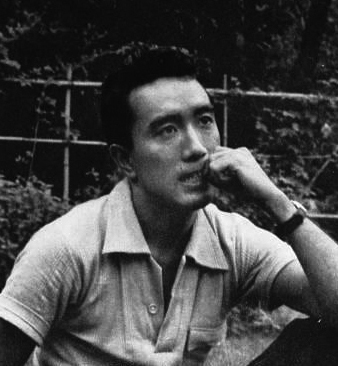From Discussions VOL. 9 NO. 2Overcoming Modernity in Yukio Mishima
KEYWORDS:
The relationship between Japan and Western Civilization has often been one of ambivalence. Little characterizes this relationship better than the conflict between traditional Japanese values, principles and sensibilities, identified as animistic naturalism, and Western values of Modernity, specifically those identified by sociologist Hitoshi Imamura:
Following the disaster of the Second World War, these issues of Modernity confronted Japanese culture; issues that the now recently fallen Imperial government had attempted to overcome through the welding together of eastern and western sensibilities in the form of the Empire of Japan. Even before this, the Meiji, Taisho, and Showa periods had themselves severely Westernized Japan. That dream however, now lay amid the smoldering ruins of Hiroshima and Nagasaki. After the war, most of Japan accepted the new American domination of their society. A few, however, including some writers and intellectuals, conscious of the modernity brought by the victorious Americans, sought out a solution to what they thought of as the problem of modernity. It is through one of these post-war Japanese intellectuals, Yukio Mishima (1925-1970), that we are able to glimpse this renewed attempt by the few intellectuals to re-explore and close the rift between traditional culture and modernity. Mishima, a very controversial figure, was consumed throughout his life by the breaking of taboos and the pursuit of a heroic death. This view of life, however, was complicated by Mishima’s struggle to reconcile his idealized view of a glorious death and the “Grand Cause,” which he attributed to the samurai and heroic kamikazes of the Second World War, as well as other Western ideas that influenced him. Subsequently, his novels, plays and films provide us with a sense of disenchantment that he feels in relation to what he perceives as the new, ever-more westernized Japan, even as he attempts to reconcile this with the Modernity present in his own ideals. Nevertheless, Mishima’s great hope is to revitalize Japan through his “tragic” philosophy in a great rebirth of blood. This can be especially seen in the last fateful act of his life, his tragically bizarre coup attempt and subsequent suicide, where we bear witness to the death he long sought. In contrast to the self-sacrifice of the hero, however, we see the last pathetic act of a man dying for his own ideals which he felt were long forgotten by an increasingly superficial and materialistic culture. Born Hiraoka Kimitake on January 14, 1925, Mishima began his life with a peculiar childhood dominated by his aged and often sickly grandmother Natsu. She had him taken away from his mother at a very young age and confined him to her sickroom. It is very likely that during this stage in Mishima’s life he began to develop his later obsessions with the infinite and death. Takao Hagiwara describes just such an argument in his article “The Metaphysics of the Womb in Yukio Mishima’s The Sailor Who Fell from Grace with the Sea,” where he identifies Mishima’s obsession with the infinite as a sort of “Womb” metaphysic, by which the grandmother’s sickroom is a form of womb. Although it keeps Mishima safe, it also confines him from the dangerous outer world, which he is fascinated with.2 Further credence of this is given by Mishima’s frequent writing about voyeurism in many of his novels. Noboru in Mishima’s The Sailor finds a small hole inside his dresser from which he can gaze into his mother’s room and through the window in the room, out onto the sea. From inside the recess in the dresser, Noboru gazes out through the hole into his mother’s room watching her undress each night, culminating in his watching her engage in sex with the sailor Ryuji, which serves as a cathartic experience during which Noboru discovers the “universal order.”3 During this whole experience, Noboru is isolated from all that he observes. He is safe in his dresser but unable to experience what he is watching. All the unfamiliar things he observes, then, take on a mystical and unattainable character. It is around this time in Mishima’s childhood that he also begins to become associated with and fascinates about, death. In Mishima’s Confessions of a Mask, often seen as at least partially autobiographical, the main character, Kochan, describes his fascination with gruesome fairy tales, in particular, a Hungarian fairy tale in which the protagonist is killed multiple times, only to be revived, again and again. He writes, “On his face was the resolve of death. If this prince had been destined to be a conqueror in the engagement with the dragon, how faint would have been his fascination for me. But fortunately the prince was destined to die.”4 What is interesting here is the described desirability of death. Mishima goes on to describe Kochan’s dissatisfaction with the fact that the prince actually magically survives the encounter and subsequent deaths and ultimately ends up rescuing his sister and marrying a beautiful princess; Mishima actually edits the story so that instead of surviving the encounter, the prince is tortured and dies, thus making his ideal ending.5 It is likely that there is a self-destructive drive in the character and, by extension, Mishima, who also read gruesome fairytales as a child and was fascinated by the deaths in them. The destructive drive is one that specifically seeks the destruction of order and beauty. Mishima describes the prince in the story being regally dressed, “looking down the terrifying throat of the raging dragon that was about to set upon him.”6 The description of the prince is one of perfect order; everything is in its proper place and the prince stands there, about to be devoured, built up perfectly, brick by brick, word by word, from Mishima’s preceding description. He is then “chewed greedily into bits” by the dragon.7 This contrast of order and disorder is characteristic of Mishima’s work. This seems to stem from the “here” vs. “there” of the unattainable that he experienced while confined to his grandmother’s sickroom as a child. Hagiwara explains that “Mishima from his earliest days was heir to two diametrically different world views: one was Apollonian and rational, the other, Dionysian and emotional. Mishima associates the Apollonian principle with masculinity and the Dionysian with femininity.”8 The diametrically different worldviews are those of Western tradition (Apollonian) and Japanese tradition (Dionysian), although Mishima attempts to create a masculine and Dionysian Japanese. In most cases where Mishima’s Apollonian and Dionysian forces collide, the conflicting elements are forced together and yield very violent results. Back to the story of the prince and dragon, the destructive Dionysian principle devours the Apollonian order principle. This underlying theme of perfection and destruction characterize much of Mishima’s work and goes on to form an integral part of his personal philosophy; this became known as the “Tragic.” The “Tragic” is formed from the struggle between the Apollonian and Dionysian. Mishima acquires this primarily from Nietzsche who argued that this conflict was the basis of Attic Tragedy.9 For Nietzsche, the Apollonain symbolized not only the plastic art form of the Greeks, sculpture, but also dreams and illusions; the Dionysian, on the other hand, symbolized the emotions and music but, most importantly, a sense of intoxication, rapture in the emotions of terror and blissful ecstasy.10 We see much of this in Mishima. For example, Mishima refers, in The Sailor to Ryuji’s body as “a suit of armor that he could cast off at will.”11 This embodies both aspects of the Apollonian principle in that the armor, much like the Greek statues, is a plastic form of art and secondly, that it is armor, hence, not the real body underneath. What is underneath is actually the Dionysian principle which, in the “Tragic” personality subordinates the Apollonian physical perfection to the raw emotive impulses of the Dionysian. We see the culmination of tragic elements in another of Mishima’s works, Patriotism or the Rite of Love and Death. In the film, a young officer in the imperial army must choose between loyalty to his fellow officers who had just participated in a coup against the government and the emperor whom he swore to serve. Being unable to stand against his brethren or the emperor the young officer decides to show his loyalty and devotion (chusei) by committing suicide with his wife. One could not ask for a more perfect representation of the “Tragic.” The announcement of the coup at the beginning of the film serves as a vehicle toward the glorious destruction of the hero rather than a major conflict. The atmosphere is also reflective of Nietzsche’s definition of the tragic: the staged production is very plastic and throughout the scene, the music of Wagner (to whom Nietzsche dedicated the Birth of Tragedy), Liebestod, is heard. That Mishima viewed himself as a “Tragic” personality with a yearning for death is without a doubt. On a superficial level, he himself had acted in the role of the officer in Patriotism and it can in many ways be seen as a rehearsal for his own suicide which is eerily similar. Mishima leaves nothing to mystery, however, and makes his yearning for death particularly clear in Sun and Steel. He writes: “The romantic impulse that had formed an undercurrent in me from boyhood on, and that made sense only as the destruction of classical perfection, lay within me... Specifically, I cherished a romantic impulse toward death.”12 This romantic impulse was to remain unfulfilled. While Mishima, over time, had built up a “Tragic” physique modeled on the classical, plastic conception of Greek art, he lacked the necessary component of the Grand Cause or, more specifically, he had missed the opportunity for it. He explains that during the Second World War: “Longing at eighteen for an early demise, I felt myself unfitted for it. I lacked, in short, the muscles suitable for a dramatic death. And it deeply offended my romantic pride that it should be this unsuitability that had permitted me to survive the war.”13 Thus, as he had survived the greatest conflagration in man’s history and also, the time most fitting for a noble death, he had essentially been cheated by history and, more specifically, Modernity, from the tragic end that he so desired.Continued on Next Page » Suggested Reading from Inquiries Journal
Inquiries Journal provides undergraduate and graduate students around the world a platform for the wide dissemination of academic work over a range of core disciplines. Representing the work of students from hundreds of institutions around the globe, Inquiries Journal's large database of academic articles is completely free. Learn more | Blog | Submit Latest in History |




















